|
|
|
Sort Order |
|
|
|
Items / Page
|
|
|
|
|
|
|
| Srl | Item |
| 1 |
ID:
172168
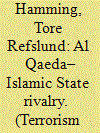

|
|
|
|
|
| Summary/Abstract |
On June 29, 2014, the Islamic State emerged and declared the establishment of its caliphate. The declaration was a direct challenge to other Sunni Jihadi groups including Al Qaeda and an attempt to become the leading Jihadi group around. The rivalry that evolved within Sunni Jihadism, and particularly between Al Qaeda and its renegade affiliate the Islamic State, entailed a hitherto unseen competitive environment within the Jihadi field. Interestingly, the increased competition did not lead to a dynamic of competitive escalation and mutual radicalization of behaviour. Theory tells us to expect competitive escalation, or outbidding, in such contexts, but despite the initial success of the Islamic State’s brutality and offensive conquest in Syria and Iraq, Al Qaeda did not “play along” and instead pursued a different path. The reason for this absence of competitive escalation, this paper argues, is to be found in a pre-conflict methodological re-orientation within Al Qaeda and in the pacifying role played by influential Al Qaeda-affiliated ideologues.
|
|
|
|
|
|
|
|
|
|
|
|
|
|
|
|
| 2 |
ID:
104943
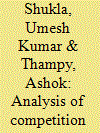

|
|
|
|
|
| Publication |
2011.
|
| Summary/Abstract |
The electricity reforms were initiated in India with the objective of promoting competition in the electricity market. In order to promote competition, the Electricity Act 2003 was enacted and various policy initiatives were taken by the Government of India. Central Electricity Regulatory Commission (CERC) also facilitated competition through the regulatory framework of availability based tariff, Indian Electricity Grid Code, open access in inter-state transmission, inter-state trading and power exchanges. Despite these initiatives, electricity prices increased in the Wholesale Electricity Market in India (WEMI). This paper analyses the market structure and competitiveness in the WEMI. There are, of course, various potential reasons for the rise in the electricity price. This paper seeks to investigate, if market power was one of the reasons for increase in market prices. Concentration ratio, Herfindahl-Hirschman index, Supply Margin Assessment, and Residual Supply Index have been used to measure market power. This paper also uses the price-cost mark-up to examine, if exercise of market power led to higher margins. The analysis suggests that market power of firms may be part of the reason for the increase in electricity prices in WEMI. The study suggests various measures to increase competition in the WEMI.
|
|
|
|
|
|
|
|
|
|
|
|
|
|
|
|
| 3 |
ID:
166041
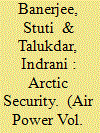

|
|
|
| 4 |
ID:
090939
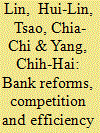

|
|
|
|
|
| Publication |
2009.
|
| Summary/Abstract |
This paper analyzes technical efficiency in China's banking system by large banks and small city banks as well as the pre-WTO and post-WTO accession periods. Using an unbalanced panel dataset for 63 banks over 1997-2006 and employing the stochastic frontier function approach, the empirical results reveal that the new entrants, small city banks, experienced a slightly higher efficiency score than incumbent large banks, on average. Compared with the pre-WTO accession period, the efficiency score is found to have improved significantly after entry into the WTO as a result of the competition effect. This competition effect is particularly relevant for small city banks. Finally, determinants of X-inefficiency are examined.
|
|
|
|
|
|
|
|
|
|
|
|
|
|
|
|
| 5 |
ID:
189305
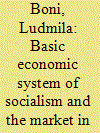

|
|
|
|
|
| Summary/Abstract |
The recognition by the Chinese academic community of the commodity economy's right to exist in a planned economy, as well as the possibility of market development under socialism, was a major breakthrough in the history of Marxism. Socialism in conjunction with the market marked the beginning of the formation of the socialist market economy system in the PRC and the development of a mixed economy. In addition, the principle of "public ownership as the basis for the joint development of economies of multiple forms of ownership" was named as the basic economic system of the country at the initial stage of socialism development. Today, it is officially called one of the most important advantages of the system of socialism with Chinese characteristics. It is this advantage, according to China, that has enabled high rates of economic growth and made the country one of the world's leading economies. But this unique feature and advantage of socialism with Chinese characteristics can be manifested and realized only within a certain coordinate system - namely, an overarching system of state administration in which the basic economic system is responsible for managing the development of the country's economy at the institutional level.
|
|
|
|
|
|
|
|
|
|
|
|
|
|
|
|
| 6 |
ID:
119595


|
|
|
| 7 |
ID:
132442
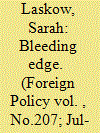

|
|
|
| 8 |
ID:
121439
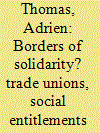

|
|
|
|
|
| Publication |
2013.
|
| Summary/Abstract |
This article explores the effects of borders on the making of trade union policies and on their capacity to act. It takes as an entry-point the reform of Luxembourg's system of family allowances and financial support for students in 2010, which redefined the group of beneficiaries and partly excluded cross-border workers from neighbouring countries. This led to heated debates in Luxembourg and in the Greater Region (comprising Luxembourg, Saarland, Rhineland-Palatinate, Lorraine and Wallonia) during which trade unions played an important part. The author explores the contradictory logics of both competition and cooperation within the Greater Region. These lead to a gap between integration as a discourse and what it means for local populations, in particular regarding labour market competition. The debates within trade unions on the issue of social entitlements for cross-border workers offer insights into the dynamics of this dichotomy and into the everyday fabric of cross-border social relations.
|
|
|
|
|
|
|
|
|
|
|
|
|
|
|
|
| 9 |
ID:
113964
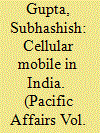

|
|
|
|
|
| Publication |
2012.
|
| Summary/Abstract |
Telecommunications has been one of the success stories of economic reforms in India. From a teledensity of 2 percent in the not too distant past the sector has grown to a point where the teledensity exceeds 60 percent. The Indian cellular market is marked by strong competition, a large number of operators and some of the cheapest tariffs in the world. The sector experiences growth rates in excess of 80 percent in terms of the number of subscribers. However, all is not well in this sector. There have been a number of upheavals in the past and the latest one involves alleged favouritism in allocating spectrum.
This paper analyzes the state of competition in the cellular mobile industry in India. Standard measures of competition such as HHI and concentration ratios are used as well as market share, revenues, access to funds and profits. We also look at the degree of rivalry in the industry through changes in rankings in market share. We provide a brief discussion of the major developments in telecommunications and cellular mobile in particular after the introduction of reforms. Effects of policy making by different institutions within India are discussed in relation to their effect on competition and market development.
|
|
|
|
|
|
|
|
|
|
|
|
|
|
|
|
| 10 |
ID:
072611
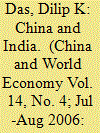

|
|
|
|
|
| Publication |
2006.
|
| Summary/Abstract |
As ancient civilizations China and India had close cultural and commercial ties, but they drifted apart after eleventh century until the mid-twentieth century. In the 1990s, the two emerging-market economies once again began to interact and become economically close. The bilateral relationship was strengthened by political initiatives and determination from both sides. Their mutual trade and investment are on the rise and their new relationship has been evolving in accordance with the new diplomatic stance of conciliation. The bilateral economic bonds are likely to involve both competitive and collaborative dimensions. The two neighbors have determined to develop more extensive cooperation in regional and international affairs.
|
|
|
|
|
|
|
|
|
|
|
|
|
|
|
|
| 11 |
ID:
112541
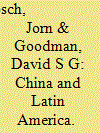

|
|
|
|
|
| Publication |
2012.
|
| Summary/Abstract |
The rise of China is not a new phenomenon. The PRC's growing economic (and in a number of cases also political) involvement in Southeast
Asia and particularly in sub-Saharan Africa has caught the attention of
academics and policymakers alike. However, China's emergence as an
important actor in Latin America has only recently appeared on the radar
screen of the scholarly community and is still an under-researched area.
Eight years have passed since Chinese President Hu Jintao's first tour of
Latin America in November 2004, marking the beginning of a new phase
in Beijing's trans-Pacific relations. The significant boost in Chinese-Latin
American trade provides strong evidence for the importance of this
emerging pattern of interaction. China's trade with the region reached
180 billion USD in 2010, evincing not only an increase of 50 per cent
from 2009 but also a pattern of sharp growth since 2000, when the China-Latin America trade volume stood at just 13 billion USD. By 2007
bilateral trade had already exceeded Hu's original target of 100 billion
USD, set for 2010 (China Daily 2011; Xinhua 2008). The articles in this
issue of the Journal of Current Chinese Affairs bear strong witness to the fact
that this budding relationship has been driven mainly by a mutual desire
to accelerate economic exchange.
|
|
|
|
|
|
|
|
|
|
|
|
|
|
|
|
| 12 |
ID:
138082
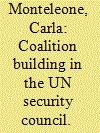

|
|
|
|
|
| Summary/Abstract |
Political coalitions in the international system are still understudied in International Relations theory. This article claims that the formation of and variations in coalitions in the international system are affected by changes in their bargaining power and bargaining environment related to the global leadership cycle and by long-term organisational changes of the international political system. Identifying the Security Council as the institution in which states are more likely to keep their systemic preferences at the institutional level, the article studies the presence, formation and change of coalitions in the international system by testing variations in the behaviour of the Security Council members in the period 1993–2012. To overcome methodological difficulties, it proposes to analyse sponsoring rather than voting behaviour. In the analysed period, the presence of a mutating dominant coalition, signs of potential coalitions in the making and an increase in participation and competition resulting from modifications in the organisational form of the international system are found.
|
|
|
|
|
|
|
|
|
|
|
|
|
|
|
|
| 13 |
ID:
174025


|
|
|
|
|
| Publication |
Boston, MA, Harvard Business Review Press, 2020.
|
| Description |
viii, 267p.hbk
|
| Standard Number |
9781633697621
|
|
|
|
|
|
|
|
|
|
|
|
Copies: C:1/I:0,R:0,Q:0
Circulation
| Accession# | Call# | Current Location | Status | Policy | Location |
| 059906 | 658.0563/IAN 059906 | Main | On Shelf | General | |
|
|
|
|
| 14 |
ID:
001059
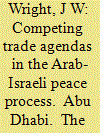

|
|
|
|
|
| Publication |
Abu Dhabi, The Emirates Centre for Strategic Studies and research, 1998.
|
| Description |
57p.
|
| Series |
Occasional paper; 23
|
|
|
|
|
|
|
|
|
|
|
|
Copies: C:2/I:0,R:0,Q:0
Circulation
| Accession# | Call# | Current Location | Status | Policy | Location |
| 040353 | 338.6048/WRI 040353 | Main | On Shelf | General | |
| D40353 | 338.6048/WRI D40353 | Main | On Shelf | General | |
|
|
|
|
| 15 |
ID:
148030
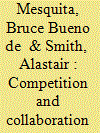

|
|
|
|
|
| Summary/Abstract |
Despite the extensive empirical and theoretical research into foreign aid, there remains little or no formal analysis of aid giving in a competitive donor environment. We endeavor to fill this lacuna with both a model and empirical analysis of aid-for-policy deals with rival aid donors. The model indicates that a dominant donor captures all the surplus from any deal. We test several hypotheses that follow from the model. We demonstrate that the United States paid less (in constant dollars) and gained more in policy terms through aid before the Soviet Union became a significant aid player. Once the Soviet Union became a player in the international aid arena, the United States paid more for aid and got less by way of security concessions from recipients.
|
|
|
|
|
|
|
|
|
|
|
|
|
|
|
|
| 16 |
ID:
087425
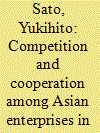

|
|
|
|
|
| Publication |
2009.
|
| Summary/Abstract |
The Asian economy has experienced tremendous changes since the late 1980s, such as the serious stagnation of the Japanese economy, the rise of many non-Japanese Asian firms, particularly in Taiwan and South Korea, and the emergence of China as an economy endowed with abundant low-cost production resources as well as a huge market. This special issue explores how Asian enterprises interact with one another amid these structural changes, with China as the arena. First and most importantly, our studies illustrate many cases of competitive and cooperative relationships among Asian firms, various kinds of cooperation in particular, which reflects the narrowing gaps among Japanese, Taiwanese, and Korean firms. Second, we also demonstrate the evolutionary process of resource/capacity building and strategic choices. Third, mutual trust built up through long-term association plays a crucial role in the collaboration between Japanese and Taiwanese firms. Fourth, although we focus on Asian enterprises, our research also shows that the multinationals from America and Europe continue to be important actors in the regional economy. Fifth, China is both a facilitator of cooperation and a stage providing opportunities for the latecomers to challenge firms from advanced countries
|
|
|
|
|
|
|
|
|
|
|
|
|
|
|
|
| 17 |
ID:
149966
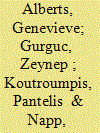

|
|
|
|
|
| Summary/Abstract |
This paper investigates the effects of information feedback mechanisms on electricity and heating usage at a student hall of residence in London. In a randomised control trial, we formulate different treatments such as feedback information and norms, as well as prize competition among subjects. We show that information and norms lead to a sharp – more than 20% - reduction in overall energy consumption. Because participants do not pay for their energy consumption this response cannot be driven by cost saving incentives. Interestingly, when combining feedback and norms with a prize competition for achieving low energy consumption, the reduction effect – while present initially – disappears in the long run. This could suggest that external rewards reduce and even destroy intrinsic motivation to change behaviour.
|
|
|
|
|
|
|
|
|
|
|
|
|
|
|
|
| 18 |
ID:
163223
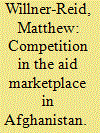

|
|
|
|
|
| Summary/Abstract |
This paper explores the dynamics of competition inherent in the “aid marketplace” in Afghanistan and proposes a holistic theoretical framework for understanding the actions of aid actors based on a taxonomy of mercenary (rational), missionary (altruistic), and misfit (bureaucratic) pressures, which both aggravate and lessen competition between actors.
|
|
|
|
|
|
|
|
|
|
|
|
|
|
|
|
| 19 |
ID:
085892
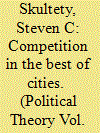

|
|
|
|
|
| Publication |
2009.
|
| Summary/Abstract |
By examining his account of individual virtues, making inferences from his analyses of flawed cities, and teasing out the tacit assumptions behind claims about the nature of political activity, I argue that Aristotle thinks of competition as being a political ideal rather than as an inevitable corruption of civic life. Virtuous citizens compete for civic honor through traditional "competitive outlays" and contend against one another for prestigious offices in the city. Moreover, I argue that the very structure of political deliberation is competitive. It is through a "vis-à-vis" competition among proposals that a winning policy is adopted, and the speakers who offer these proposals are themselves involved in a competition for political influence.
|
|
|
|
|
|
|
|
|
|
|
|
|
|
|
|
| 20 |
ID:
112325
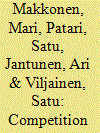

|
|
|
|
|
| Publication |
2012.
|
| Summary/Abstract |
Internal European electricity markets are a target set by the European Union (EU) and under development at present. This article presents the findings of a Delphi study focusing on the prospects of European electricity markets. The main aim is to report the obstacles that participants in the survey felt were the most critical ones affecting competition in the European electricity markets of the future. The respondents were European electricity market specialists, and the themes of the survey ranged from transmission networks and electricity trade to demand flexibility. One of the key findings was shared concern over the adequacy of transmission network capacity in Europe. It was considered that technical issues, such as existing transmission network bottlenecks, are most likely to form obstacles to creating common European electricity markets if new capacity is not built quickly enough. It was seen by the panellists that electricity trading arrangements, whilst important, are unlikely to form a barrier to the development of an internal electricity market. It was noted that electricity trading issues have recently been the subject of development work in the EU.
|
|
|
|
|
|
|
|
|
|
|
|
|
|
|
|
|
|
|
|
|